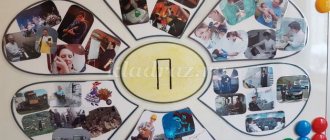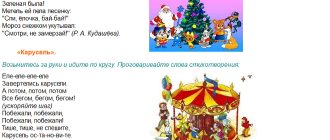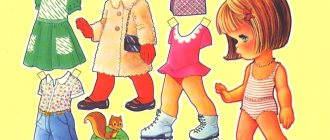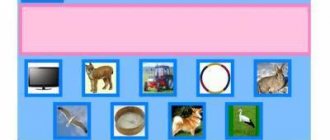Verbal and didactic games for children of the younger group of preschool educational institutions
Verbal and didactic games for children of primary preschool age in preschool educational institutions
Verbal and didactic game “Compare different animals” (2-3 years) Purpose : to teach children to compare different animals from fairy tales, highlighting the opposite characteristics. Number of players: 5-6 children Game rule: the child who is pointed to by the driver answers. Game action: The teacher invites the children to look at the Bear and the mouse. - The bear is big, and the mouse... (small). What kind of bear? (Thick, thick-footed, club-footed). What kind of mouse? (Small, grey, fast, dexterous.) What does Mishka like? (Honey, raspberries), and the mouse loves ... (cheese, crackers). — Mishka’s paws are thick, and the mouse’s…(thin). Who has the longest tail? The mouse has a long tail, and Mishka ... (short. Similarly, you can compare other animals from fairy tales - the fox and the hare, the wolf and the bear. Verbal and didactic game “Kids and the Bunny” Purpose: To teach children to come up with a new ending to a familiar fairy tale Number of players: 4-6 children Game rule: listen carefully to your interlocutor Game action: First, the children remember the fairy tale “The Little Goats and the Wolf". It can be recalled using a tabletop theater or a flannelograph. The fairy tale ends, but the teacher offers to listen to what happened next: “The goat went back to forest. The kids were left alone at home. Suddenly there was a knock on the door again. The kids got scared and hid. And it was a small... (the toy is shown) bunny. The bunny says: ...("Don't be afraid of me, it's me, the little bunny.") The kids... ( let the bunny in). They treated him...(cabbage, carrots). The kids ate and began... (play, have fun, frolic). The bunny played... (on the drum), and the kids... (jumped merrily). Verbal and didactic game “Chicken- Ryabushka” based on the fairy tale “Ryabushka Hen” Purpose: To develop speech activity in children, practice interrogative intonation with them, and train them in correct sound pronunciation. Number of players: a subgroup of children Game rules: the chicken must loudly and quickly answer the children’s questions Game action: the teacher shows a picture of a pockmarked hen, suggests remembering the fairy tale “Ryaba the Hen”. After telling the tale, he explains why it is called “Ryaba”. Then he invites the children to play. A chicken is chosen using a counting machine. The teacher puts a cap on her, puts her in front of the children and starts asking questions. The chicken answers them at the prompting of the teacher: - Chicken Ryaba, where did you go? - To the river. - Chicken Ryaba, why did you go? - For some water. - Chicken Ryaba, why do you need some water? - Water the chickens. - Chicken Ryaba, how do your chickens ask for water? - Pi-pi-pi-pi! (All children say this.) When playing the game again, the teacher suggests to the children: “Let’s all ask the chicken together where she went?” The children, together with the teacher, trying to reproduce a questioning intonation, ask: “Ryaba Hen, where did you go?” etc. It is better to choose shy, timid, silent children as chickens. 4. Printed board game “Paired Pictures” Purpose: To train children in comparing objects depicted in the picture, in finding similarities and in selecting identical images; cultivate attention, concentration, form speech, develop the ability to follow the rules of the game. Material: paired pictures-illustrations from Russian folk tales and chips Game rules: Show and name only the same picture; Whoever correctly selects and names the paired picture will receive a chip. Game action: searching for the necessary cards. Printed board game “Add a picture” Purpose: To train children in composing a whole object from its parts; cultivate will, perseverance, determination Number of players: Game rules: Don’t make a mistake in choosing. The one who folded and named his picture before the others wins. Game action: searching for parts, folding the whole picture. Printed board game “Loto” Purpose: To train children in the ability to combine objects according to their place of growth: where what grows; to consolidate children's knowledge about Russian folk tales Number of players: Game rules: cover the cells only with those pictures that correspond to the content of the large card, i.e. the fairy tale Game action: find small cards with images of episodes from fairy tales and cover the cells on the large map with them. Competition - who will be the first to cover all the cards Printed board game “Domino” (2-3 years) Purpose: To consolidate children’s knowledge about Russian folk tales, to name the fairy tale correctly Number of players: Game rules: Place the cards one by one, next to the same picture. The winner is the one who puts all the cards first. Game action: If the player does not have a paired card, he skips the turn and waits for a paired picture to appear at either end. When the game is repeated, the cards are dealt out again.
We recommend watching:
Do-it-yourself didactic panel “Fishes” for children 2-3 years old Games for the development of phonemic hearing and consolidation of correct pronunciation in children 3-4 years old Didactic games for developing hygiene skills in children of the younger group of preschool educational institutions Summary of the game for children of the younger group to develop communication skills
Similar articles:
Educational games for children 2-3 years old in kindergarten. Card index
Didactic game for children 2-3 years old “Let’s feed the doll lunch”
Didactic game for children 2-3 years old “Dolls visiting children”
Didactic games on social development in the younger group of kindergarten
Games with objects for children 1-3 years old
Card index of games for the development of speech of young children
Card index of games for the development of speech of young children
Osmanova E.A.
Game "Morning Greeting"
Target:
creating a positive emotional climate in the group, developing communication skills, speech development, instilling the skill of greeting each child in the group.
Content:
Children and an adult stand in a circle. Everyone joins hands.
The adult, turning his gaze to each one in turn, says: “We all woke up and got together. And Tolya is here... And Sasha is here...” All the children repeat after the adults. The adult and the children greet each other: “Hello, Tolya! Hello, Sasha!.. Hello, sun!”
Then the teacher looks at each child and says: “Everyone is here!” The children repeat in chorus: “Everyone is here!” and shake hands (or hug each other) tightly.
Game "Looking for a friend"
Target:
Teaching children cooperation skills, moving from playing “side by side” to playing “together”.
Content:
Children are given one toy each (a set consisting of 2-3 toys of the same type: hares, bears, dogs, etc.)
The teacher tells the children that now they will dance along with the animals. But it’s boring for one bunny or one bear to dance, so while the music is playing, each child must find friends for his little animal. (At the first stage, the teacher draws attention to the fact that the set contains not one bunny (bear, dog), but several).
When the music starts playing, the children walk around the room and look for children with paired toys, that is, they are looking for a friend for their little animal. When a friend is found, the children dance together with the toys.
(Instead of toys, you can use pictures of animals or medals that can be hung on your chest).
Game "Help Tanya"
Target:
Developing partner communication skills, increasing motivation to communicate, developing speech, relieving anxiety in children.
Content:
The teacher says that the girl Tanya has a problem: all her toys are broken, and she has nothing to play with anymore. Children are shown several pre-selected toys, each of which is divided into two parts. For example, a mushroom cap and a mushroom stem, two parts of one nesting doll, etc. For older people, you can divide the toy into 3-4 parts.
The received parts are distributed to children - one for each child - and they are asked to help Tanya fix the toys. The kids' task is to find the individual parts of the toy and connect them.
Note:
This game is similar to the game "Looking for a Friend", but is more functional, because... it can also be used in working with “special” children. For example, for anxious children, the instructions for the game are clear and accessible, but before the game starts, the teacher must demonstrate what the repaired toys will look like. For autistic children it will be easier to complete a task with a logical conclusion (the toy is whole again)
Game "Gifts"
Target:
formation of the need for communication, speech development, formation of a subjective emotional attitude towards a peer.
Content:
An adult asks the children if they like to receive gifts and, having received a positive answer, suggests: “Let's pretend to give gifts.” Then he calls one child to him, to the center, then everyone says:
We brought gifts to everyone,
Whoever wants it will take it
Here's a doll with a bright ribbon,
Horse, top and plane.
The toys must be listed slowly and expressively so that the children have time to imagine each item. Then, turning to the child who will be “given” the gift, the teacher asks which of the listed items he would like to receive. If the baby chooses a horse, the rest of the children gallop like horses. If it’s a doll, they dance like dolls and sing songs. If it’s a top, they spin with the sound “w”. If the plane - Depict the flight and landing of the plane, spreading their arms and reproducing the roar of the engine: “r”.
Let the child choose a “gift” (one of the children). And the one he chose goes to the center of the room. Now he will choose a gift.
Note:
Naturally, gifts can be diversified - for example, you can offer a choice of a butterfly, a frog, a bear, a car, etc., which are easy to depict in motion. To do this, you need to compose poems about these toys in advance.
Game "Try to Guess"
Target:
Development of empathy, tactile perception, speech development, development of communication skills, group cohesion.
Content:
All children sit on the carpet. One child - the driver - turns his back to them. Children take turns touching his shoulder, back, stroking him and saying:
One two three four five,
Try to guess.
I'm with you here.
Tell me what my name is.
The driver tries to guess who stroked him. If the driver cannot guess correctly, he turns to face the players, and they show him who stroked him, and he simply tries to remember and say the name of this child.
Note:
A modification of this game is the game “This is Me. Get to know me.”
Children also sit on the carpet. One of them turns his back to those sitting. The children take turns patting him on the back and saying: “It’s me. Recognize me.”
The teacher helps the child guess by calling out the names of all the children in turn.
It is advisable for each child to play the role of leader.
Game "Velcro"
Target:
developing communication skills, the ability to listen to instructions; teach to coordinate your actions with the actions of others, promote speech development in children.
Content:
Children run around the group to cheerful music. Two children, holding hands, are trying to catch their peers. At the same time, they refrain (sentence): “I am a sticky stick, I want to catch you.” Each caught child is taken by the Velcro hand and joined to his “Velcro company.” Then they all catch the other children together.
When all the children become Velcro, they dance and say, “We are Velcro. We will dance together."
Note:
At first, until the children have mastered the game, an adult acts as Velcro.
Game "Do as I do"
Target:
creating optimal conditions for physical contact and exchange of emotions; contribute to the formation of a positive attitude towards peers, the formation of speech development.
Content:
The teacher says to the baby: “I took Nikita’s hand. Look. Do as I do.” He gets the child to repeat the request, emphasizing that this is Nikita. Or: “I hug Alyosha, he’s good. Do as I do." “I gave the car to Kolya. Do as I do,” etc.
Game "Mirror"
Target:
developing adult-child interaction skills; the formation of an understanding that another child and an adult are the same (can do the same, is similar, etc.), the development of speech in children.
Content:
Stage 1 - individual. An adult takes the child to the mirror. Draws his attention to the image appearing in it. Then he says: “Now I will be a mirror.” The child “looks in the mirror”, and the teacher repeats his movements. Next, the teacher and the child change roles. The teacher conducts similar exercises with all children in turn, separately.
Stage 2 – group. The conditions of the game are becoming more complicated. All children stand in a circle (if they are small, in one line, opposite the teacher) and become “little mirrors.” The teacher shows the movement, and they repeat it. The teacher accompanies the movement with the words: “My friend, look at me and repeat everything after me.”
Game "Beads for Friends"
Target:
to cultivate the ability to enter into emotional and practical interaction with a group of peers, to form a sense of unity and community with each other, and to develop speech in children.
Content:
The teacher shows the children a doll wearing beautiful beads. The children look at it, the beads. Then the doll's beads break and she asks the children to help her put the beads back together. The children all together collect the scattered bead rings and string them onto one common string. The doll thanks the children for their help. She brought a lot of strings and beads as gifts for the children. The doll invites the children to make beads for each other. (You can suggest collecting beads from any multi-colored beads, or you can use single-colored ones: red beads on a red rope). When the children make the beads, they need to try them on and admire each other. You can also offer to give your beads to each other. The doll praises everyone, says that everyone is beautiful and good. At the end there is a general dance to cheerful music.
Game “Hide and Seek with Handkerchiefs”
Target:
developing children's communication skills; fostering friendliness and a desire to play with each other; evoke positive emotions and promote speech development in children.
Content:
The teacher hands out handkerchiefs to each child. He suggests playing hide and seek: “Let’s all hide now. I will look for you." Children put scarves over their heads. Educator: “Where is our Nastya? Nastenka, where are you? The named child takes the scarf from his head and says: “Here I am!” In this way, the teacher “finds” all the children.
When children learn to play, you can invite one of the children to look for everyone. Older children can be asked to tell about each other: their names, what they are, what they have (body parts, clothes). You can also hide under one scarf for 2-3 children.
You can play Hide and Seek with toys. An adult hides a toy under a handkerchief, then shows any part of it (cockerel comb, bunny ears, etc.) or makes a sound characteristic of this toy (Ku-ka-re-ku, quack, etc.) and asks to guess who is hiding there . If the child guessed right, then this toy is given to him (there should be toys according to the number of children). Afterwards, the children can hide their toy under their handkerchief and call it: “Cockerel (cuckoo) come here!”
Target:
to form the need for communication, promote the formation of an emotionally positive attitude towards peers and the development of speech in children.
Content:
Children and an adult sit in a circle on a rug. An adult sings the song “We are sitting, we are sitting and looking at Tanya.” At the same time, he always points to the child he is singing about, calls his name again and asks the children to repeat it. Or, on the contrary, she asks to show the child about whom she sang: “Where is our Tanya?”
Then you can sing (say) which child it is. For example: “Our Tanya is good, Our Tanya is pretty. Tanya has eyes, hands, etc.” (here the teacher can come up with any kind words about the child). There must also be physical contact: patting the head, touching hands, etc. (You can also involve children in this).
Note:
The adult must reach out to all the children. Afterwards, as a conclusion, the teacher says that all the children are good today and offers to pet themselves and each other. Children stroke their arms, legs, tummy, cheeks, saying: “We are good, we are good...”
Game "We are sitting, we are sitting..."
Game "Pyramid of Love"
Target:
create an atmosphere of closeness and community between children, a positive emotional climate in the group; development of communication skills.
Content:
Children stand in a tight circle and take turns putting their hands on top of each other (building a pyramid). At the moment when the child puts his hand on the teacher’s hand, the teacher says: “We love you, Vova!” Then another child puts a hand on top, the teacher says: “We love you, Denis!” etc. When the “pyramid of love” is built, the teacher invites the children to close their eyes and feel how warm their hands are. The teacher encourages the children, if possible, to pronounce the words after her.
"Let's get acquainted"
Target:
teach how to find peers in a group, say their names, thereby developing children’s speech, and developing the ability to establish contact with children.
Content:
The teacher says: “A gnome (bear, doll) came to visit us. Let’s get to know him and tell him our names.” The children, together with the teacher, sit on the carpet in a circle with a gnome standing in the middle. The teacher rolls the ball to each child and says, calling each person’s name, for example: “Sasha is with us.” Children repeat (if possible).
Note:
Game content may vary.
For example, “Show me who I name.”
Children sit on the carpet or just play. The teacher asks the child: “Where is Sveta? (Dasha, Kolya, etc.)” The child points to the one who was named. The teacher asks you to repeat the name: “This is Sveta. Say “Sveta.”
"Who is this?"
The teacher asks to say your name, to say what the name of this or that baby is. If the child finds it difficult, the teacher helps him and asks him to repeat.
During the game, the teacher necessarily accompanies his speech with gestures, touching the person whose name must be called.
Game "Roll the ball"
Target:
to form a sense of community, cultivate the ability to enter into emotional and practical interaction with each other and develop children’s speech.
Content:
An adult and children are sitting on the carpet. An adult takes the ball and rolls it towards one of the children: “The ball rolled to visit Lena, catch it quickly!” After the child catches the ball, he invites him to roll the ball to another child: “Lena, who does the ball want to go to visit?” If the baby cannot choose a child, he helps him: “Roll the ball to Vova!”
Every child should take part in the game. Then the teacher offers to throw the ball to each other in the same way.
Note:
You can modify the game: roll the ball not across the entire field, but in a circle from one child to another. While rolling the ball, you need to comment on its movements: “Now Sasha has the ball, and Sasha rolled the ball to Vanya!”
Game "Only Together"
Target:
teaching children to establish contact with each other, teach them to adapt to the pace of their partner’s movement.
Content:
Children stand in pairs and hold the ball together (each tries to hold the ball with both hands). At the teacher’s signal, the children must simultaneously sit down, trying not to let go of the ball, walk through the group, and jump. Their main task is not to drop the ball and to learn to act in a coordinated manner.
Note:
When children master this version of the game, its conditions can be complicated, for example, like this: each child can hold the ball with only one hand
Game "Locomotive"
Target:
Teach children to interact with each other, teach them to carefully observe each other’s actions, listen to each other and adults (visual and physical contact), promote the development of children’s speech.
Content:
The teacher invites the children to ride the train. “Nikita will be the locomotive, and we will all be carriages. Cars, stand behind the engine." Children stand one after another and move around the group, saying the name of the child engine: "Nikita, Nikita, Nikita... Tu-tu...". Then another child is appointed as the engine.
Note:
Younger children can play the game with an adult or one or two children.
Game "Snowflakes"
Target:
development of communication skills, ability to listen to instructions.
Content:
The teacher invites the children to turn into snowflakes. To the sound of cheerful music, children run around the room and spin (snowflakes fly). At the teacher’s signal, they turn into a big snowball - they run up to the teacher and hug him closely.
Game "Finger on finger"
Content:
Children stand at random. The teacher reads (sings) the following poem:
Finger on finger: knock-knock.
Fist on fist: knock-knock
Methodology for conducting word games
During the game, the teacher guides the progress of the game and teaches the children. His speech should be grammatically correct, calm, but at the same time emotional. You cannot direct your gaze, facial expressions and gestures to only one player. You need to look first at one child, then at another, so that everyone thinks that the teacher is addressing him specifically. Therefore, he must know the text of the game, story, fable or nursery rhyme by heart. It is necessary to stand or sit during the game so that all children can see the teacher’s face and watch his eyes and lip movements.
If parents are busy at work all day and find it difficult to find time to communicate and play with their baby, then the time before bedtime is perfect for these purposes. While bathing the baby, dressing him for bed, communicate and play.
Offer to name certain words, grouping them according to a single characteristic. For example, let the baby name 5-10 names of girls, the same number of names of boys, names of flowers, etc. If he has coped with such a task, you can complicate the requirements and ask him to name the same objects, only so that they begin with the same letter.
Psychologists and teachers have developed special methodological recommendations for organizing and conducting speech games.
- The choice of game depends both on the age and level of development of the children in the group, and on the task set by the teacher or special education teacher. Tasks can be educational, educational and correctional.
- The game should not be too easy, otherwise it will not stimulate mental activity, and children will quickly lose interest in it. It should also not be too complicated so that children can find the right solutions on their own, and not just with the help of an adult.
- The game should evoke positive emotions in children, so at the beginning of the game you need to create a gaming mood. If you need to distribute roles between children for the game, then you can use a counting rhyme; it sets the mood for the game perfectly.
- In order for word games to give positive results, they need to be gradually complicated, new elements added, and visual aids can be used. However, new games must be introduced gradually.
- Games must be organized in such a way that all children are involved. Even if only one child answers, everyone should be busy finding the right solution.
- For games to be effective, you need to alternate between working with the whole group and individual work with the child.
- Great care should be taken to ensure that children strictly adhere to the rules of the game. This teaches them to be disciplined. For children in the junior kindergarten group, the rules are explained during the game itself.
A verbal game can occupy any place in the pedagogical activity of a teacher. It can be used during group activities, during children's entertainment, and even while walking.
For children aged 3-4 years, you can already offer word games with letters. This will help the baby quickly and efficiently master the alphabet and develop memory. While playing, you can cut out a new letter from colored cardboard on each new day. By pronouncing words starting with this letter, the child will be able to correctly associate them with the outline of the letter, which will have a positive impact on his further development and learning.






